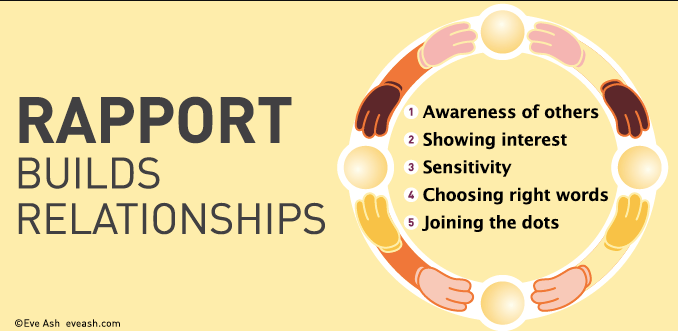In today’s business environment, success depends on the managers’ ability to take everyone associated with their business into confidence. The step is all the more crucial while making essential business decisions. In such situations, organizations can no longer ignore the importance of stakeholders. There is no doubt that they can influence an organization’s future course. Therefore, you must provide stakeholders with the opportunity to express their views on decisions and policies that affect them. An excellent example of building rapport is proactively asking the stakeholders about their problems before they point out possible issues.
If you do not proactively seek out stakeholders’ views, they may demand consultation sooner or later. Further, such situations may force organizations into a defensive position, leading to loss of reputation and trust.
Organizations must become aware of the changes in society and the business environment. It will help mitigate the adverse effects of those changes on their business prospects. Consciously building a good rapport with the stakeholders is part of that process.
What are the Stakeholders?
Stakeholder engagement is crucial for all types of businesses,. It is also the fundamental aspect of corporate responsibility. Building rapport with all the stakeholders of your business is vital for its smooth progress. A stakeholder relationship powered by mutual trust can help remove potential obstacles and ease the path to growth.
Stakeholders are individuals or groups that affect or are affected by your organization and its business plans and policies. Moreover, they have the power to influence the organization. The primary stakeholders of a business are its investors, employees, customers, and suppliers. However, with corporate social responsibility coming into sharp focus, the concept of stakeholders now extends to communities the business effects, and governments they liaise with.
While building rapport with customers is a given, companies need to look beyond financial gain. As with any other business process, building a good rapport with all stakeholders should be organized and practical. Besides, past experiences in the management of stakeholders will shape future planning and engagement.
What Is Rapport Building?
Building rapport with clients is not a linear process. Instead, it is an iterative process in which the organization refines and improves its ability to achieve meaningful engagement. Besides, organizations should aim to build rapport on an ongoing basis in place of one-off consultations.
What are the Stages of Rapport Building?
The process of establishing a good rapport, leading to better stakeholder engagement, involves the following stages.
- Identify the objectives that need addressing, and recognize the stakeholders whose support is critical for achieving those objectives.
- Acknowledge the concerns of the stakeholders, the legitimacy of their interest, and the influence or power over outcomes.
- Understand their objectives and motivations, and use the analysis to profile and prioritize stakeholders.
- Find common ground between your organization and the stakeholders, and use it to establish rapport. Note that you must do this exercise with all the stakeholders and not just the easy ones.
- Provide a detailed, holistic picture by contextualizing information. Moreover, ensure that stakeholders have the complete picture needed to arrive at a reasonable conclusion.
Apart from the above, your efforts at building rapport must also involve a realistic stance while negotiating for possible trade-offs. It will help you in driving the conversation toward an agreement. Most importantly, by being pragmatic and objective, you can build trust with the stakeholders.
An excellent method for building rapport with stakeholders is asking them leading questions.
What Are Some Rapport-building Questions?
You can build rapport by asking the right rapport-building questions. It can help create a conducive environment for building rapport and establishing a robust relationship.
Examples of rapport-building questions are as follows.
- How can we plan our next steps together?
- What can I do to help resolve your issues?
- Would you please let us know how we can strategize without hurting your interests?
- How can we work as a team to solve the problems?
You cannot expect all the stakeholders to veer towards your point of view. Each stakeholder needs a personalized method of negotiation. By using rapport-building questions in the conversation, you can help drive the point that you want to have a good relationship home.
The template created for the individual case must incorporate the stakeholders’ issues in the order of importance. At the same time, you must anticipate the possible reaction of stakeholders to your proposal and prepare with appropriate responses. A measured and practical response can create a sense of fairness and help in building rapport of an intense nature.
One of the foolproof methods of building rapport and boosting relationships with the stakeholders is to ensure transparency of the process. You can achieve it by providing accurate documentation. Also, share all key progress points with the stakeholders in a format and language they understand.

What is Required to Encourage Rapport Building?
You must establish a set of rules to follow within the organization to encourage and foster meaningful relationships.
- Building rapport and trust with stakeholders is crucial. However, do not be too quick to judge and never jump to conclusions about their motivations.
- Having a clear view of motivation of both sides can help close the gap between differences
- Recognize the fact that the fundamental motivation of each party may be very different. Accepting this can help arrive at a practical solution to the contentious issues.
The organization must accept and appreciate the significance of engaging with the stakeholders. Additionally, they must commit to creating a positive vibe for future success and benefits. Most importantly, the organization must define and articulate how it plans to engage with the stakeholders.
For achieving this, it should form a team of people with the right temperament and maturity to ensure the desired outcome.
The Benefits of Engaging With Stakeholders
When you start building rapport with the stakeholders, it helps add value to the business operations side of your organization. It can reduce constraints in vital areas of business operations. Moreover, it can increase the ability to operate without hindrances.
Engaging with stakeholders allows you to:
- Plan for the future
- Mitigate risks
- Boost opportunities
- Adjust to the changing social, economic, political, and technological environment
- Understand the divergent views of critics better
- Address criticisms and disparaging comments more convincingly
Developing and building rapport with clients will allow you to reassure stakeholders that you are attentive to their issues.
Today, organizations better understand the risks connected with stakeholder relations and the opportunities it presents. They are aware that stakeholders can be critical for business performance. Therefore, many of them have established dedicated departments to manage activities in this domain.
There is this strong belief that earning the goodwill of stakeholders is not only one more positive thing for the company’s development. It is vital for gaining a competitive advantage. The message is becoming increasingly clear that organizations must effectively and convincingly serve the needs of all their key stakeholders. Moreover, this is vital to remain competitive and progressive. Organizations that know how to build rapport will survive and thrive. Those that fail to build rapport will lag, become a blip, and disappear.
How to Engage Stakeholders and Build Rapport?
Make an effort to manage stakeholder relationships like the way you handle any other business function. While planning an engagement with them, execute the process like running any business project planning process. It must involve in-depth analysis, proper preparation, precise implementation, accurate reporting, and flawless assessment and follow-up.
With the right engagement strategy, organizations can secure a wide range of benefits. These include the ability to move towards its stated goals without the risk of facing any serious resistance. It also provides the freedom to implement strategies and growth programs smoothly. They will have the license to implement expansion programs by introducing new products and services.
At times, there could be lapses in the stakeholder engagement process. Organizations and managers may undermine stakeholder relations or misread their influencing abilities. It can create a sense of mistrust and tension. It can also make it difficult for organizations to manage future successful relationships smoothly.
How to Use Established Rapport to Achieve Objectives?
Once an organization has identified the importance of building rapport with its stakeholders, it must focus on the objectives they want to achieve through this enhanced relationship. It is not just about opportunity management or managing your communications better, as many tend to believe. It’s about identifying the problems you want to address and the stakeholders you want to focus on to achieve the desired results. It will depend on the type of your business, the sectors you are focused on, and your business model.
Carry out an accurate and detailed assessment of the stakeholders that are a priority for your organization. Make plans to get into the good books of those priority stakeholders. Your task involves the following.
- Understand how they think and arrive at decisions
- Know what motivates them
- Try to find out what objectives they seek
- Know their expectations from your organization
- Find out what influences their vision and interpretation of issues
- Decode their methods of cultivating and building relationships
Understanding and appreciating these elements will boost the chances of engaging successfully with your chosen stakeholders.
When the interests and objectives of the organization and the stakeholders align, it can help achieve great success for your business goals. Most importantly, you can do this by making continuous efforts to build rapport. It will allow you to leverage the benefits of the relationship thus established.
Of course, it is impractical to assume that both parties want an identical outcome. However, it becomes easy to implement a solution acceptable to both parties by identifying shared areas of interest.

How to Build Rapport With Team Members?
Recent research has stated the importance of achieving greater alignment between the interests of stakeholders and decision-makers. Furthermore, this calibration is also crucial between various units of a business. That is because different business departments may have different needs. Therefore, it may create misalignment on how to engage meaningfully.
For building rapport between the team members, constitute an internal or in-house stakeholder management team. Such a team can communicate with the local units and understand their views and issues. Subsequently, it can convey them to the central department for a more coordinated approach.
Organizations must dedicate time and resources to recognize the possible common areas between them and the stakeholders. If they identify these commonalities and collate the research before the meeting, the chances of reaching a consensus improve significantly. Moreover, such efforts can even help reduce the chances of failure, even when there are apparent gaps between the parties. That is because they know that there are shared interests to explore, bringing the discussion back on track.
First, you must decide which stakeholders to involve in the consultation process and the most appropriate mechanisms to be applied. The next step is to identify the issues of interest or concern to each group of stakeholders. Most importantly, these pain points rely on local realities and the characteristics of stakeholders. It is critical not to lose sight of the topics and record the issues you are handling.
You must update the outcome of every such meeting in the central forum for consumption of every business unit. Otherwise, there is a danger of units contradicting organizational goals during individual interactions with their respective stakeholders. It can derail the endeavor to reach a consensus. Furthermore, it can put months of untiring efforts to gain stakeholders’ trust and goodwill to waste.
Impactful Techniques for Building Rapport
Often, we come across strangers and strike conversations with them. Sometimes, we feel comfortable in their company within minutes! That’s what good communication skills can do to build relationships.
Some people have the inherent quality of making you feel comfortable when they speak. You instinctively develop a bond of trust with them. Furthermore, will not feel that they are making an extra effort at building rapport.
You can be successful at building rapport by using a few of these impactful conversation techniques.
- Identify a positive aspect of a person and start your conversation around that point. You can grab attention immediately.
- Switch the conversation to an area of interest of the person to whom you are talking. You will be surprised at the impact it creates.
- Before initiating a dialog, find out some details about the person at both personal and professional levels. Try to introduce these in the conversation to strike a rapport quickly.
- Be a good listener. We all love to air our opinions, but listening closely to the person shows respect for their views. That is an instant rapport generator.
Two-way Connections to Which You Must Contribute With
Building rapport is always a two-way effort, and cannot be achieved in silos. Therefore, work hard to create the right settings. Above all, be mindful of the circumstances in which you can win the stakeholders’ trust. Furthermore, take small steps toward building rapport with them and improving on the same.
Listening carefully and interjecting only when needed is vital to keep the conversation on the right path. You can do it by identifying common grounds so that you can initiate small talk around those topics. Then, move on to the core areas of discussion.
Be sincere and make genuine efforts to create a bond. However, trying too hard might derail progress as it might appear forced. As you become more reliable in delivering your commitments, you will experience a positive change in the outlook of stakeholders. Then, the initial resistance will give way to a welcome camaraderie to keep building a robust relationship.
Wrapping Up
Excellent stakeholder relationships can be built and maintained by using the tips and techniques mentioned in this article. It is impossible not to have a different viewpoint on certain aspects. However, address them while keeping in mind the overall organizational objective.
As mentioned, always take an interest in what the other person has to say and be a good listener. Try to send the message across that every step you are taking is for the common benefit of all parties concerned.
Be transparent and honest in your communication. Finally, always treat your stakeholders like long-term investment partners who can help you grow and flourish together.





